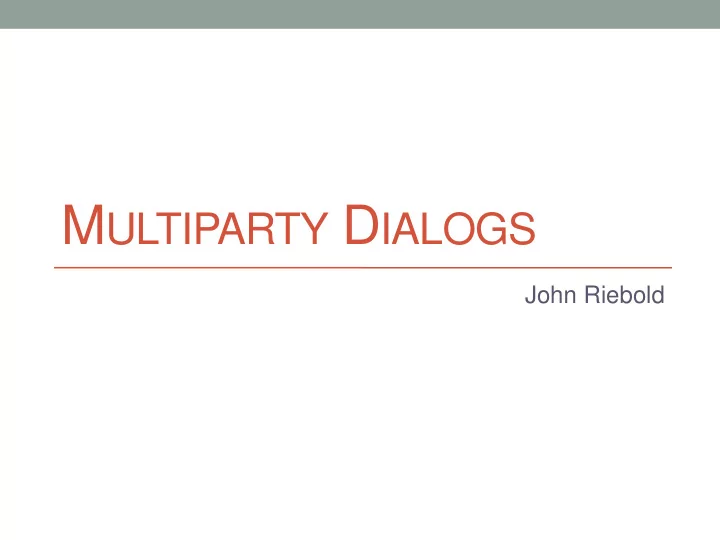

M ULTIPARTY D IALOGS John Riebold
Participant Roles • Conversational Roles • 2 participants: • Speaker • Addressee • 3+ participants: • Speaker • Addressee • Auditor (known, ratified) • Overhearer (known, non-ratified) • Eavesdropper (unknown, non-ratified) (Bell, 1984)
Participant Roles • Speaker Identification • Difficult in multiparty dialogs • Can be done acoustically, with a microphone array, or visually • Addressee Recognition • Multiparty dialogs present many more possibilities • Addressee can be inferred from content (e.g. name, position/rank, etc.) • Can also be done with positional audio or video
Participant Roles • Addressee Recognition • Jovanovic & op den Akker (2004) presents a set of features that could be used to perform addressee recognition: • Speech • Linguistic markers (e.g. to infer person, number) • Names • Rank/title? • Dialog acts (specifically, relation to previous conversation and effect on subsequent conversation • Gaze • Gesture • Context (e.g. user/conversation history, spatial organization)
Participant Roles • Speaker & Addressee Identification • Bohus & Horvitz (2009) used video to identify speakers and addressees • Part of a more sophisticated engagement system
Interaction Management • Turn Management • Turn-taking in multiparty dialog can be complex • More agents available to take a turn • Humans may drop some turn-taking expectations in conversation with a machine, but won’t with other people • Depending on the system, crucial evidence may not be available (e.g. video, audio)
Interaction Management • Turn Management • Bohus & Horvitz (2011) • Used Decision Theory to model turn-taking and allow the system to take the floor at relevant junctures • Leveraged audio/video info, previous turn info, time since previous turn, processing delays, and cost • Compared heuristic vs. learned (MaxEnt) models of floor release, and heuristic vs. Decision-theoretic models of turn-taking policy Model Cost Floor Release Inference Policy Heuristic Heuristic 0.43 Learned Heuristic 0.29 Learned Decision-theoretic 0.21
Interaction Management • Channel Management • Multiparty dialogs may have multiple channels (i.e. multiple conversations) • May share a single channel (i.e. single topic, one speaker at a time)
Interaction Management • Thread/Conversation Management • Multiparty systems must manage a complex set of shifting (and often linked) topics • Side conversations can entail an entirely separate set of threads • Current thread bears on turn-taking, obligations, grounding, etc.
Interaction Management • Thread/Conversation Management • Purver, et al. (2007) look at the automatic detection of subdialogs • Detection of subdialogs is done with classifiers using various features: • ngrams • Utterance length • Prosody • Time expression tags • Dialog acts • Context • Classifiers outperform the baseline, but take a hit when using errorful ASR input
Interaction Management • Initiative Management • Multiparty may have unevenly-distributed initiative • Speakers can defer to others • Interruptions are more likely
Interaction Management • Attention Management • Managing multiple (possibly uninvolved) participants is necessary in multiparty systems • Bohus & Horvitz (2009) model multiparty engagement using acoustic, positional, visual, and tactile information
Grounding and Obligation • Multiparty dialogs may have very complex grounding and obligations • If information is presented in one conversation, must it be grounded in another? • How should a system handle transfer of obligation?
Grounding and Obligation • Purver , et al. (2007) also look at the automatic detection of ‘action items’ (obligations) • They train a classifier to rank phrases based on various features: • Phrase length • Phrase probability • Parse probability • Syntactic features (class, theta roles, main verb, head noun, etc.) • Time expression tags • Evaluated based on amount task descriptions covered by top-ranked fragment • Results for timeframe phrases were above baseline, but still relatively low (f-score 0.51, precision 0.62). Results for description were worse, with no feature set outperforming the baseline.
Discussion • What possible use cases are there for systems like MSR’s Situated Interaction? • Would it be worth implementing these systems in commercial applications? • Are there other cues or types of information that aren’t being used in these models?
References Bell, A. ( 1984 ) Language Style as Audience Design. In Coupland, N. and A. Jaworski (eds.) Sociolinguistics: a Reader and Coursebook , pp. 240-50. New York: St Martin's Press Inc. Bohus, D. & Horvitz, E. ( 2009 ) Models for Multiparty Engagement in Open-World Dialog. In Proceedings of SIGdial 2009 . Bohus, D. & Horvitz, E. ( 2011 ) Decisions about Turns in Multiparty Conversation: From Perception to Action. In ICMI-2011 . Jovanovic, N. & op den Akker, R. ( 2004 ) Towards automatic addressee identification in multi-party dialogues. In Proceedings of Sigdial 2004 . Purver, M., Dowding, J., Niekrasz, J., Ehlen, P., Noorbaloochi, S., & Peters, S. ( 2007 ) Detecting and Summarizing Action Items in Multi-Party Dialogue. In Proceedings of SIGdial 2007 , p. 18-25. Traum, D. ( 2004 ) Issues in multiparty dialogues. In F. Dignum (ed.), Advances in Agent Communication . Springer-Verlag LNAI 2922, p. 201-211.
Recommend
More recommend